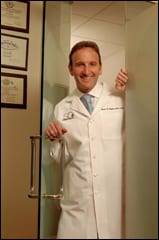 |
At the ASPS meeting in Chicago, the “Hot Topics 2008” session on November 1 showcased seven separate panels and 30 presenters who spoke to a standing room-only crowd of members for 5 hours. A range of topics was covered, from fillers to cellulite to wound closure and tattoo removal.
At the heart of the session, though, placed in the post-luncheon “prime time” slot between 1 and 3 pm, were three panels that addressed the immediate concerns of everyone practicing cosmetic medicine today—fat removal, laser-based liposuction, and a “neurotoxin update” mirrored procedures that account for a large part of most aesthetic surgeons’ revenues.
THE “RELAXING EXPRESSIONS” BUSINESS
The robustness of Botox Cosmetic sales—even in the face of a recession—makes one fact abundantly clear: relaxing the stress muscles of the face is a sine qua non of facial rejuvenation. Many researchers have invested time and money looking for ways to paralyze facial muscles without using needles. Some have succeeded.
The solution that is sure to garner media attention (and the gratitude of patients who harbor a fear of needles) is the topical neurotoxin.
Michael Kane, MD, explained the chemistry of these new muscle relaxers, showing how they’d adapt to an office setting. Besides being used for facial rejuvenation, they will be indicated for sweat reduction. You’ll see them under such brand names as PurTox, Reloxin, and Xeomin.
A second new approach to paralyzing stress muscles is radiofrequency nerve ablation. David M. Knize, MD, presented the GFX radiofrequency system, already FDA-approved, which uses a metal probe to release radiofrequency energy into facial muscles to produce a temporary paralyzing effect. The selling
point here isn’t noninvasiveness (the probe breaks the skin just as a needle would) but rather duration. Early estimates reckon that GFX treatments will last for 18 months—many times the duration of current Botox Cosmetic injections.
 |
FAT REMOVAL
“Radiofrequency” came up again in presentations about the technology of fat removal. “Bipolar Radiofrequency for Body Contouring,” presented by Malcolm Paul, MD, FACS, made the case for using radiofrequency waves (as opposed to ultrasound) to break up fat cells before removing them with a traditional cannula. The technology has been submitted for FDA approval.
The venerable Sydney Coleman, MD, presented another promising fat-removal approach, cryolipolysis. As its name implies, this approach turns the melting paradigm on its head by freezing fat. Using energy extraction, the technology crystallizes lipids to ease the removal process. In animal experiments, cryolipolysis has been shown to reduce fat layers by 35%.
Jeffrey Kenkel, MD, FACS, of the University of Texas, illustrated yet another fat removal innovation: Ultrashape ultrasound liposuction. Distinct from traditional ultrasound technology, it’s already being used in 57 countries but has yet to win FDA approval.
LASER-BASED LIPO
These liposuction techniques have already won market share, highlighting the public’s hunger for lower-impact lipo. New candidates are emerging to compete in this hotly contested field. Lasers of various kinds have been shown to be effective in preparing fat cells for extraction and in promoting skin contracture, too.
Leading off the panel on this subject was Barry DiBernardo, MD, FACS, who talked about Ulthera, a noninvasive deep skin tightening procedure. With this modality, fat removal is secondary to skin contracture. Ulthera uses focused ultrasound energy to tighten the skin’s surface and diminish wrinkles. It is reportedly so effective that it’s being considered as a non-invasive alternative to surgical brow lift.
Thomas Dressel, MD, presented LipoEze, another laser-based liposuction technology that uses laser energy to chemically alter fat cells—another technology currently awaiting FDA approval. DiBernardo took the stand once again to summarize the good news about SmartLipo, which has been showing excellent results across the board for people with redundant or lax skin.
FAT GRAFTING
The notion of removing hip/buttock/thigh fat and using it for autologous transfers to the breast has intrinsic appeal. Women with pear-shaped bodies are particularly drawn to the idea. It relieves them of the onus of being overweight. Instead, their fat is simply “stored in the wrong areas.” A “natural” procedure that transferred the fat cells upward to the breast region would seem less artificial than breast implants and liposuction—until you look at the facts.
As presented by Roger Khouri, MD, FACS, in the final “Potpourri” of Hot Topics, fat transfers to the breast are far from natural. The technology involves a cumbersome process of expanding breast tissue to render it porous enough to accept fat grafts.
Joyce Sunila has 30 years’ experience in medical marketing. She can be reached at www.practicehelpers.com.




